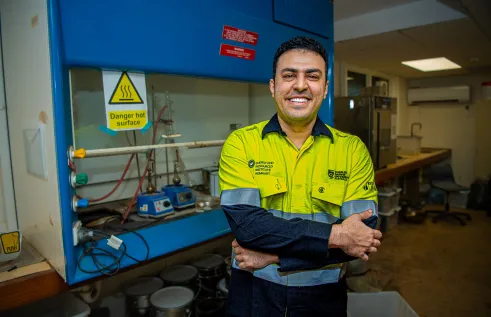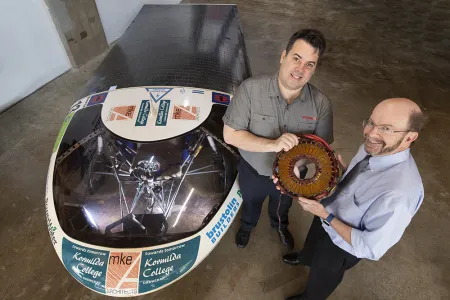News article
NT’s pioneering solar car on display in CBD
Darwin’s history as an early leader in solar car technology is on display in the Smith Street Mall.
The Desert Rose 2001, which was a Northern Territory entry in the World Solar Car Challenge that year, was designed by students and staff at the Northern Territory University (NTU), which became Charles Darwin University (CDU).
The NTU team competed in the World Solar Car Challenge with various versions of the Desert Rose between 1987 and 2005 under the leadership of Dr Dean Patterson, who held various senior positions in the NTU’s Department of Electrical Engineering and was awarded an Honorary Doctorate of Science by CDU in 2018.
After many successful years racing against industry giants such as General Motors and Honda, in 2000 the Desert Rose was awarded the world speed record for solar cars; averaging 107kmph over the 3000km race.
Desert Rose 2001 has been brought out of retirement in a collaboration between CDU and the NT Government to showcase early innovations in solar car technology in the lead-up to this year’s Bridgestone World Solar Challenge, which gets underway on Sunday.
A key innovation developed by the university through the Desert Rose program was the motor that powered the vehicle, which is continuing to power innovation today.
The motor was commercialised in 2001 by Steve Camilleri and Byron Kennedy – two members of the university’s solar car development team.
“The axial flux motor technology developed in the engineering of the Desert Rose is now used around the world and is arguably one of the most successful commercial spinoffs from solar car racing,” Mr Camilleri said.
The pair formed the company In Motion Technology (IMT), which manufactured the axial flux motor in factories around the world and built the company’s expertise in advanced manufacturing processes.
“It was through this process and experiencing first-hand the difficulty of sourcing quality metal components, that we identified metal manufacturing as the next area of disruption,“ Mr Camilleri said.
With the proceeds of the sale of IMT in 2015, the pair formed the 3D metal printing company SPEE3D.
SPEE3D and CDU have collaborated to form the Advanced Manufacturing Alliance, which is now recognised as a centre of excellence for real-world applications on 3D printing technology.
“A modest university engineering program to build a solar car capable of travelling from Darwin to Adelaide that developed one of the most enduring pieces of solar car technology has resulted in Darwin leading the way on the next wave of manufacturing innovation in the form of 3D metal printing,” Mr Camilleri said.
“The Desert Rose 2001 might not be as space-age looking as the multi-million-dollar entries in this year’s race, but it was part of a program built around ingenuity, innovation and lateral thinking that made history and developed ground-breaking technology.”
The history of the vehicle, and the axial flux motor that powered it, are now on display in the Activate Darwin hub in the Smith Street Mall.
Related Articles

Conservation planning ‘good for biodiversity and business’
The Northern Territory’s investment in solar and wind energy production needs to benefit people and the planet, but new research highlights critical pitfalls in planning.
Read more about Conservation planning ‘good for biodiversity and business’
Where rubber meets the road: Old tyres are key to building tougher roads
Almost half of the Northern Territory’s worn-out tyres end up in landfills – with the rest exported interstate for recycling – but a study led by Charles Darwin University (CDU) is repurposing the discarded rubber to build stronger, sustainable roads that meet the NT’s unique needs.
Read more about Where rubber meets the road: Old tyres are key to building tougher roads
Social media subjecting Black women to radicalised digital policing
Influencers use oppression, manipulation and weaponisation to police Black women on social media, according to new research uncovering the entrenched nature of digital racism.
Read more about Social media subjecting Black women to radicalised digital policing
